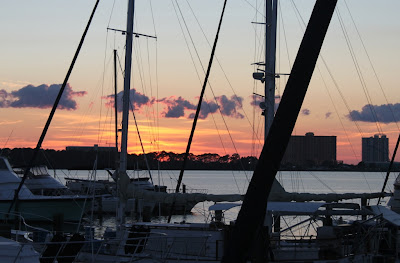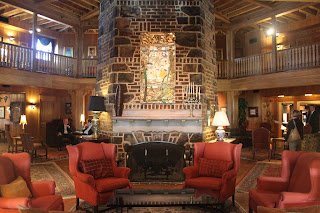Day 74 and 75 - November 26-27, 2012: Crossing the Gulf of Mexico
When luck is on your side, life is good.
We crossed Lake Michigan, navigated the river system, traversed Mobile Bay and the Gulf ICW, and then we got our chance to take on the challenge of crossing the Gulf of Mexico. This part of the loop is much talked about and feared by some boaters who have never been out of sight of land. Bear with me, as this post covers our activities over two long days.
The crossing is 180 miles from Apalachicola to Tarpon Springs, and some have reported very difficult conditions with 5 to 7 foot waves, high winds, and visibility hampered by darkness. With a "fast" boat and lots of fuel, one can make it in a single day and in daylight; however, most of us run "slow" boats and require 18 to 20 hours and are out overnight. If you take risk and go unwisely, there are no good nearby ports to divert to mid-voyage.
Fortunately, there is an AGLCA member, Tom, who publishes Tom's Weather Musings on the forum daily, and makes recommendations to loopers about whether the weather is appropriate to cross. He is a legend and highly respected for his experience and advice. He told us at the AGLCA Rendezvous that sometimes in December there are only one or two safe opportunities for an overnight crossing, so we had been more than concerned about being able to get to Tarpon Springs where we would leave the boat and go home for Christmas.
Since we were starting in Panama City Beach, FL, we first needed to get to Apalachicola, a distance of 70 miles, and it took 7 hours against a pesky 3 mph tide. To go 9 mph ground speed, we needed to go up to 12 mph on the water and this used quite a bit of fuel. Most of the way, we were in a man-made canal with little to see, but as we came into Apalachicola, there were dolphins that came out to play. They can easily swim at 9 mph and like to either jump or surf the wake.
 |
| Dolphin jumping the wake |
 |
| Dolphin surfing the wake |
After crossing under the Apalachicola Bridge at 3:00 PM, we followed the ICW 22 miles to East Pass and entered the Gulf at 5:30 PM just before dusk. We were now committed to a crossing. I had found another looper boat on the forum that was interested in doing the crossing together, and we caught up to David and Joy on MAIA and started across.
 |
| Sunset over the Gulf of Mexico |
Tom had promised a perfect crossing, and he was right on the money. The winds were low, the waves were never over 1 foot, mostly under 1/2 foot and sometimes almost glass. Most incredibly, we had a full moon from dusk to dawn which allowed us to look out over the Gulf and know all was well.
 |
| Full moon rising over the Gulf of Mexico |
Anne and I took turns with 4 hour shifts at the helm, sleeping in between, and she did an admiral (pun) job of keeping us on track and safe. This included her first time running after dark, her first time using the radar, and our first overnight passage. I knew she was nervous about this part of our adventure, so I was very relieved.
We arrived in Tarpon Springs at 1:30 PM after 30 hours of continuous cruising over two days, and both of us enjoyed every minute. We followed MAIA, a 42 foot Grand Banks, up the channel, and docked at Turtle Cove Marina for a well-deserved rest.
 |
| MAIA was our companion for the crossing |
We feel very blessed to have had such a great day after so much preparation, anticipation and some anxiety over this crossing.
 |
| Great Laker resting after a long two days underway |



















































